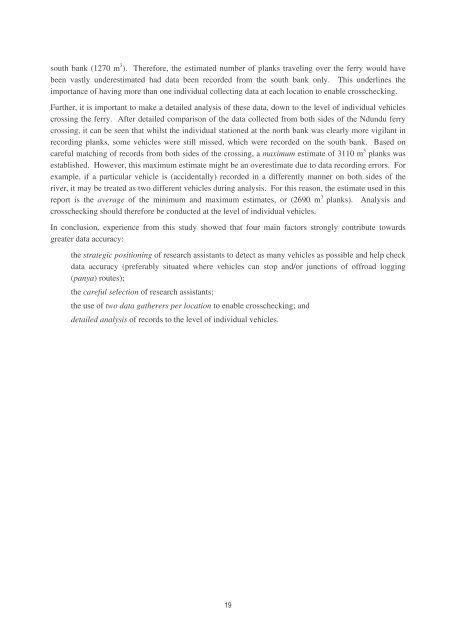Bridging the Gap: linking timber trade with infrastructural ...
Bridging the Gap: linking timber trade with infrastructural ...
Bridging the Gap: linking timber trade with infrastructural ...
You also want an ePaper? Increase the reach of your titles
YUMPU automatically turns print PDFs into web optimized ePapers that Google loves.
south bank (1270 m 3 ). Therefore, <strong>the</strong> estimated number of planks traveling over <strong>the</strong> ferry would have<br />
been vastly underestimated had data been recorded from <strong>the</strong> south bank only. This underlines <strong>the</strong><br />
importance of having more than one individual collecting data at each location to enable crosschecking.<br />
Fur<strong>the</strong>r, it is important to make a detailed analysis of <strong>the</strong>se data, down to <strong>the</strong> level of individual vehicles<br />
crossing <strong>the</strong> ferry. After detailed comparison of <strong>the</strong> data collected from both sides of <strong>the</strong> Ndundu ferry<br />
crossing, it can be seen that whilst <strong>the</strong> individual stationed at <strong>the</strong> north bank was clearly more vigilant in<br />
recording planks, some vehicles were still missed, which were recorded on <strong>the</strong> south bank. Based on<br />
careful matching of records from both sides of <strong>the</strong> crossing, a maximum estimate of 3110 m 3 planks was<br />
established. However, this maximum estimate might be an overestimate due to data recording errors. For<br />
example, if a particular vehicle is (accidentally) recorded in a differently manner on both sides of <strong>the</strong><br />
river, it may be treated as two different vehicles during analysis. For this reason, <strong>the</strong> estimate used in this<br />
report is <strong>the</strong> average of <strong>the</strong> minimum and maximum estimates, or (2690 m 3 planks). Analysis and<br />
crosschecking should <strong>the</strong>refore be conducted at <strong>the</strong> level of individual vehicles.<br />
In conclusion, experience from this study showed that four main factors strongly contribute towards<br />
greater data accuracy:<br />
<strong>the</strong> strategic positioning of research assistants to detect as many vehicles as possible and help check<br />
data accuracy (preferably situated where vehicles can stop and/or junctions of offroad logging<br />
(panya) routes);<br />
<strong>the</strong> careful selection of research assistants;<br />
<strong>the</strong> use of two data ga<strong>the</strong>rers per location to enable crosschecking; and<br />
detailed analysis of records to <strong>the</strong> level of individual vehicles.<br />
19
















